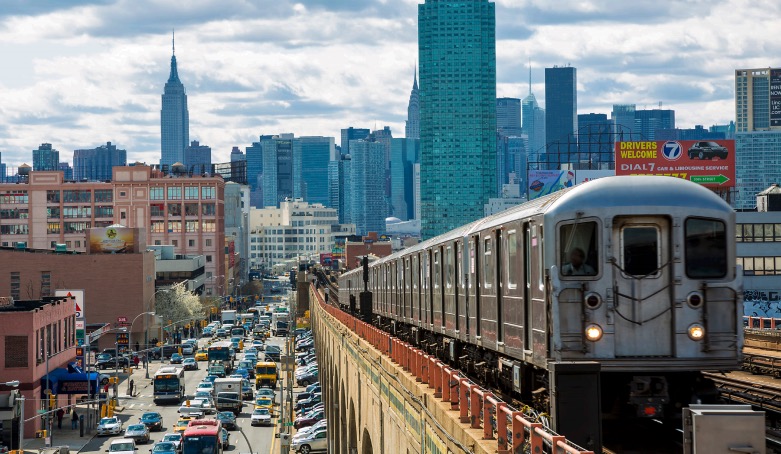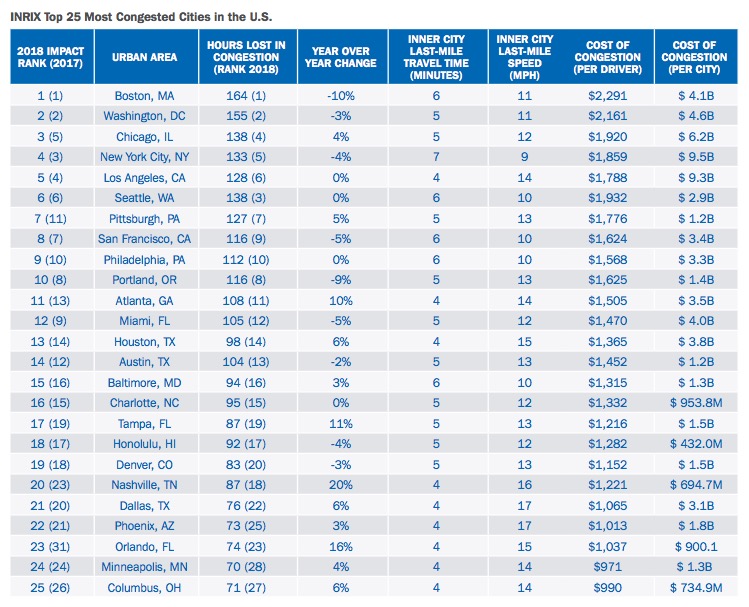INRIX RESEARCH
Introduction
 Congestion is an indiscriminate global phenomenon that is dramatically impacted by population, the economy, infrastructure, and the proliferation of rideshare and delivery services. It also imposes massive costs both economically and socially. Solving traffic – better stated, improving mobility – requires a tailored approach to each city’s needs.
Congestion is an indiscriminate global phenomenon that is dramatically impacted by population, the economy, infrastructure, and the proliferation of rideshare and delivery services. It also imposes massive costs both economically and socially. Solving traffic – better stated, improving mobility – requires a tailored approach to each city’s needs.
The INRIX 2018 Global Traffic Scorecard is an analysis of congestion and mobility trends in more than 200 cities, across 38 countries. A new methodology for the 2018 Global Traffic Scorecard allows for cross-national rankings and analysis, delivering in-depth insights for drivers and policy-makers to make better decisions informed by big data.
INRIX collects billions of anonymous data points every day from a diverse set of sources, including connected vehicles, cities, DOTs, road weather conditions, journalistic incidents, social media, parking, mobile and other IoT devices. With information on almost 90 percent of the world’s roads across over 80 countries, INRIX is the preferred provider of driving and mobility intelligence for leading automakers.
Congestion
Congestion at the most basic level can be described as the demand for road space exceeding supply. However, the critical phenomena known as ‘facility breakdown’ is frequently underappreciated. It occurs when a road cannot effectively accommodate more vehicles, which causes a decrease in the roadway’s overall capacity as more vehicles try to force their way onto the roads.
Highways designed to operate safely at speeds of 60 MPH, can move nearly 2300 cars per lane per hour at 45 MPH. The same roadway may carry fewer than 700 cars per lane during facility breakdown. Facility breakdown is why expansion and congestion relief measures frequently fail as the supply of road-space cannot increase enough to escape this trap. While this example pertains to highways, every road and/or road network is subject to facility breakdown. For instance, urban streets are subject to greater mobility demands than car-exclusive roadways.
INRIX Research recognizes that commute duration remains mostly constant across cities worldwide, irrespective of congestion levels. On average, commuters are unwilling to spend more than one hour per day commuting according to Marchetti’s constant. Trip times are kept in check by increased housing density, household relocation and greater mobility via infrastructure improvements. According to INRIX data, travel speeds, congestion rates and time loss positively correlate with population and city density. However, motorists in high congestion cities do not typically travel as far since they are geographically closer to more destinations. It is the driving experience that differs most across cities, not the duration of trips. Typically, dense cities experience low speeds and shorter commute distances in contrast to low-density cities which exhibit higher speeds, but longer distances traveled. In both contexts, commuters spend approximately a half-hour on average going to or from work.
One notable exception to this trend is Singapore. With aggressive anti-congestion policies, including high vehicle ownership fees and congestion tolls, the city’s road network continues to facilitate high-speeds despite high urban density. Charging for road space curtails the incidence and impact of facility breakdown. In Paris, Zurich, Barcelona and Madrid, authorities actively pursue policies that reduce roadway performance and capacity in favor of public transport, cycling and walking. Prioritizing safety, often under the title of ‘Vision Zero’, has justifiably taken on much greater emphasis in recent years, and with significant success. New York City, for example, achieved the lowest number of roadway fatalities on record in 2018. Sustainable measures are sought for many reasons, including mobility, environmental, safety, health and economic considerations. When interpreting the 2018 Global Traffic Scorecard’s results, understanding the context of road performance within a city’s broader mobility framework is critical.
Data and Methodology
The INRIX 2018 Global Traffic Scorecard is not directly comparable to the 2017 Global Traffic Scorecard due to different metrics and criteria of analysis. The 2017 Global Traffic Scorecard measured time spent in congestion for the median commuter whereas the 2018 Global Traffic Scorecard measures time lost due to congestion dependent upon the time of day. The 2018 Global Traffic Scorecard not only analyzes time lost, but also the severity of congestion.
The 2018 Global Traffic Scorecard addresses the above by employing peak, off-peak and free flow data for the busiest commuting corridors identified by data density. Peak corresponds to the absolute worst portion of the morning and afternoon commute. Off-peak is the low point between the peak periods. Free flow is the best performance experienced over 24 hours. Employing free-flow data enables a direct comparison between peak and off-peak periods and serves as the basis for calculating time loss. Total time lost is the difference in travel times experienced during the peak and off-peak periods compared to free flow conditions on a per capita basis.
For example, Los Angeles experiences high levels of congestion throughout the day, but its peak severity is less than Boston and Washington D.C. In other terms, Boston and Washington D.C. experience lower lows compared to Los Angeles’ consistently congested roadways, although all three are heavily congested. Congestion severity correlates with city age and density because cities tend to develop around the popular transportation modes of the period.
The 2018 Global Traffic Scorecard uses two years of historical data to provide a complete year-over-year comparison of congestion and mobility. A multi-year approach enables the identification of trends in the world’s largest cities and provides a basis for comparison.
Definitions:
- Impact Rank: Impact rank is a calculated commute based upon a city’s population and the delay attributable to congestion.
- Urban Area: The geographic scope of a city as defined by its road network density.
- Hours Lost in Congestion: The total number of hours lost in congestion during peak commute periods compared to free-flow conditions.
- Year-Over-Year Change: The percentage difference in hours lost in congestion in 2018 compared to 2017.
- Last Mile Travel Time: The time it takes to travel one mile into the central business district during peak hours.
- Last Mile Speed: The speed at which a driver can expect to travel one mile into the central business district during peak hours.
Economic Impacts
The economic impacts associated with driving are pervasive, complex and dynamic. To understand the burden congestion places on each driver and the economy, INRIX Research estimates the costs of congestion in the United States, United Kingdom and Germany.
Time Loss to Passenger and Freight
Time loss is the excess amount of time taken on a trip caused by congestion. The cost of congestion depends upon the labor market, industrial sector, mode of transport, trip distance and travel conditions. Two preferred methods for developing estimates for work and non-work passengers’ travel time savings (non-freight movements) are revealed preference method and the cost-saving approach. Given the limited availability of this data, creating a definitive answer for the costs of time loss for passengers is difficult. However, ranges are derived for cities in the U.S., U.K., and Germany based upon U.S Department of Transportation guidance. Costs were then calculated in local currencies using 2018 values.
Congestion also increases the costs of freight movement via reduced driver productivity, higher operating costs and decreased reliability. A high degree of variability exists between cities due to local economic conditions and the type of goods transported.
For example, the impacts of delays on perishable goods are much higher than durable goods. Thus, the costs of congestion vary severely between cities. However, the American Transportation Research Institute estimates the total cost of congestion in the freight sector to be $74.5 billion annually, with $66.1 billion of it occurring in urban areas.
Congestion as an Economic Indicator
While congestion incurs costs from time loss, increased pollution rates, and higher incidents of accidents, its presence is indicative of positive economic trends and a city’s desirability. The occurrence of many of the world’s most dynamic cities in this report should serve as no surprise. Higher density and population correlate directly with economic growth and innovation rates, while their cooccurrence has a multiplier effect. The larger and denser the city is the more significant the benefits accrued to an individual city. Agglomeration economics is the phenomena of increasing productivity as a function of size and density. For example, the Top 5 largest metros in the U.S. by GDP accounted for 26 percent of the nation’s GDP, in 2017, but represented only 17 percent of the nation’s population. While congestion itself has little intrinsic worth, it’s symptomatic of economic vitality. In the medium- and longterm, congestion can positively impact a city by catalyzing land use changes and driving investment in high-efficiency modes of transport (public transport, bicycling, walking). These investments reinforce agglomeration economics, amplifying their impact.
Congestion Rankings in the United States
Boston and Washington D.C. are the top two cities in the U.S. both in terms of impact and time wasted. Drivers in each city lose up to 164 and 155 hours in traffic, respectively. Their geography, age and density create a road network that enters a severe state of breakdown once traffic strikes. In each, drivers experience congestion more than 15 hours per year greater than the next worst cities in terms of total hours: Chicago (138) and Seattle (138). Based upon Federal Department of Transportation time loss valuations, Boston drivers lose up to $2,291 per year, while Washington D.C. drivers lose up to $2,161. Nationwide, drivers lose 97 hours in congestion, which costs Americans $87 billion annually in time, an average of $1,348 per driver.
While this report provides a snapshot of the economic costs of congestion in cities, it does not reflect the impact of the time loss for individuals of different incomes. Boston may incur the most significant costs in dollar terms, but a robust public transit system means alternatives exist for lower-income households. In contrast, in a city like Houston (up to $1,365), many households depend on driving, which is more expensive on a per mile basis. Determining the true impacts of congestion is dependent upon a city’s unique economic profile and commute trends.
The cities with the slowest downtown business districts in the U.S. are New York City, San Francisco and Philadelphia (9 MPH, 10 MPH and 10 MPH, respectfully). Again, their slow speeds make sense as they are amongst the country’s oldest and densest – New York City and San Francisco being the two densest cities in the U.S. – meaning cycling is equal to or faster than driving. The driving characteristics in these cities’ cores affirms their decisions to prioritize safety, public transport and non-motorized modes.
Download full version (registration required): Global Traffic Scorecard
About INRIX
inrix.com
Founded in 2005, INRIX pioneered the practice of managing traffic by analyzing data not just from road sensors, but also from vehicles. This breakthrough approach enabled INRIX to become one of the leading providers of data and insight into how people move around the world.
Tags: Congestion, Global Traffic Scorecard, INRIX, INRIX Research, Traffic, Traffic Rankings, Worst cities for traffic








 RSS Feed
RSS Feed